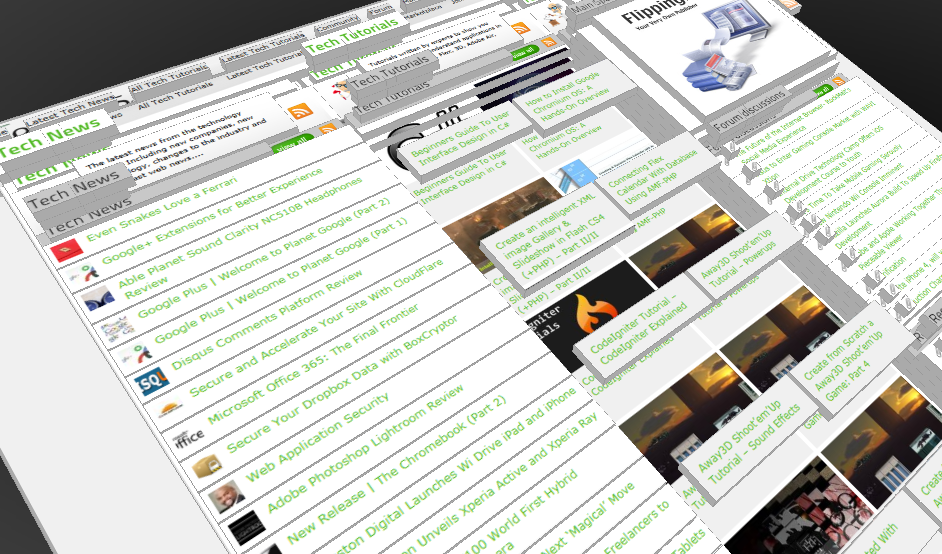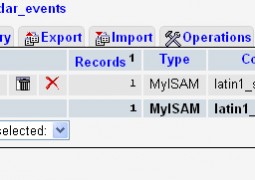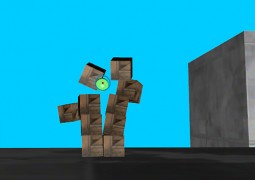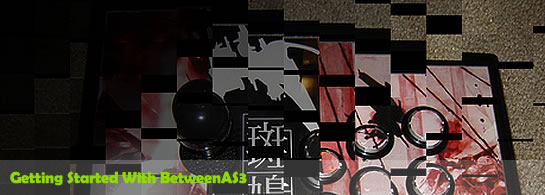Extending the Actionscript 3.0 / Flash CS3 Slideshow with XML
by 10 September, 2008 11:34 pm79
In this second part tutorial we’re going to add some more features to the slideshow application.
Those would be forwarding and rewinding slides, play and pause the slideshow and linkable slides. If you haven’t read the first part tutorial yet, you should do it before continue. You can read it here.
Requirements
Adobe Flash CS3
Sample files:
Adjust XML structure
To store the link of each slide, we just add it as an attribute to the xml file, or to be more accurate, on the image nodes. We also set the target window of the link, which might be neccesary to set in some cases. So, our xml is looking now like this:
<slideshow> <image src="images/fly.jpg" desc="Fly" link="http://www.wikipedia.org" target="_self"/> <image src="images/mouse.jpg" desc="Computer mouse" link="http://www.google.com" target="_blank"/> <image src="images/country.jpg" desc="Country" link="https://www.thetechlabs.com" target="_self"/> <image src="images/rope.jpg" desc="Rope" link="http://www.amazon.com" target="_blank"/> <image src="images/flower.jpg" desc="Flower" link="http://www.adobe.com" target="_self"/> </slideshow>
Adding new objects
Since we know, how the xml looks like, we can move on to the knew stuff on the stage. In the mcInfo movieclip we’ve added 4 new buttons. Pause/Play and Forward/Rewind, which will later be assigned to event listeners. On the main stage is a invisible button as big as the size of the slides which will be used to open the links defined in the xml.
Alright, that’s already enough to go on with the coding part.
Adding new variables
First of all, we need to add some new variables to our script.
To know, if the slideshow is currently playing or paused, we set a flag:
var bolPlaying:Boolean = true;
And we also store the current slide link and target window in a variable:
var strLink:String = ""; var strTarget:String = "";
Init function
This is all we need for the variable. Now let’s take a look about what’s changing in the init function of the slideshow. We added the following two lines at the beginning of the function to prevent the user to click any button as long as the xml file hasn’t been loaded completely:
mcInfo.visible = false; btnLink.visible = false;
We’ve also changed the function that will be called once the slideTimer event is fired. Now the function nextSlide() will be called, which we’ll create later:
slideTimer.addEventListener(TimerEvent.TIMER, nextSlide);
On the last line of the initSlideshow() function we add the event listeners for the buttons. The play and button pause event listeners will be assigned to the same function togglePause(). The next and previous button will be asssigned to the nextSlide() and previousSlide() function. And last of all, we connect the invisible link button that covers the slide area with the goToWebsite() function. And since our slideshow will automatically be playing at the beginning, we hide the play button.
btnLink.addEventListener(MouseEvent.CLICK, goToWebsite); mcInfo.btnPlay.addEventListener(MouseEvent.CLICK, togglePause); mcInfo.btnPause.addEventListener(MouseEvent.CLICK, togglePause); mcInfo.btnNext.addEventListener(MouseEvent.CLICK, nextSlide); mcInfo.btnPrevious.addEventListener(MouseEvent.CLICK, previousSlide); mcInfo.btnPlay.visible = false;
onXMLLoadComplete function
Once the xml is completely loaded, we need to show the mcInfo and the button link again. So we add the following two line of code to the function onXMLLoadComplete()
mcInfo.visible = true; btnLink.visible = true;
And since our switchSlide() function will now need to have the index number of the slide, we add a zero as the parameter. We’ll explain the changes in the switchSlide() function later.
switchSlide(0);
NextSlide/PreviousSide function
Let’s take a look at the nextSlide() and previousSlide() functions. They are called when clicking the next and previous button and the nextSlide() function is also called when the Timer event of the sliderTimer has been fired.
The nextSlide() function checks, if there are any slides left to move on. If so, the current switchSlide() function will be called with the next slide index. If there are no more slides left, then the parameter will be zero standing for the first slide.
The previousSlide() function works the same way. If there are slide we can go back, then the switchSlide() function will be called with the previous slide index. If we’re already on the first slide, then we start the slideshow from the last slide with calling the switchSlide() function with the parameter of the total slide count minus one since the array count begins with zero.
function nextSlide(e:Event = null):void {
if(intCurrentSlide + 1 < intSlideCount)
switchSlide(intCurrentSlide + 1);
else
switchSlide(0);
}
function previousSlide(e:Event = null):void {
if(intCurrentSlide - 1 >= 0)
switchSlide(intCurrentSlide - 1);
else
switchSlide(intSlideCount - 1);
}
SwitchSlide function
Since the nextSlide() and previousSlide() functions are now handling the checking for the slides, we can take out this part in the switchSlide() function.
To prevent the user from clicking too fast on the next and previous button, we check, if the tweener is still fading in the slides. If so, we just ignore the action. We’re doing this by adding the following if-statement to the first line of the switchSlide() function.
if(!Tweener.isTweening(currentContainer)) {
Now we only need to set the new link and the target of it. This will be done exactly the same way as setting the description of the slide.
strLink = xmlSlideshow..image[intCurrentSlide].@link; strTarget = xmlSlideshow..image[intCurrentSlide].@target;
FadeSideIn function
The fadeSlideIn() function has also a small addition. We check if the slideshow is currently playing and show the number of seconds to the next slide. If the slideshow is paused, we show a status message. The text will be assigned to the lbl_info label.
if(bolPlaying) {
mcInfo.lbl_loading.text = "Next slide in " + TIMER_DELAY / 1000 + " sec.";
} else {
mcInfo.lbl_loading.text = "Slideshow paused";
}
OnSlideFadeIn function
On the onSlideFadeIn() function we now need to check, if the slideshow is playing. If so, we can start the timer again:
if(bolPlaying && !slideTimer.running) slideTimer.start();
TogglePause function
The togglePause() function will be called when the user clicks on the play and pause button. First, we check, if the slideshow is playing, if so, we show the play button, set the bolPlaying variable to false, change the status message of the lbl_info label to “Slideshow paused” and stop the timer.
If the slideshow is currently paused, we show the pause button, set the bolPlaying variable to true again, show the time to the next slide and restart the timer.
function togglePause(e:MouseEvent):void {
if(bolPlaying) {
mcInfo.btnPlay.visible = true;
mcInfo.btnPause.visible = false;
bolPlaying = false;
mcInfo.lbl_loading.text = "Slideshow paused";
slideTimer.stop();
} else {
mcInfo.btnPlay.visible = false;
mcInfo.btnPause.visible = true;
bolPlaying = true;
mcInfo.lbl_loading.text = "Next slide in " + TIMER_DELAY / 1000 + " sec.";
slideTimer.reset();
slideTimer.start();
}
}
GotToWebsite function
The last function we need to define is the goToWebsite() function. This function will be called once the user clicks on the invisible button. It will check, if the strLink variable is empty or null. If not, the link will be opened.
function goToWebsite(e:MouseEvent):void {
if(strLink != "" && strLink != null) {
navigateToURL(new URLRequest(strLink), strTarget);
}
}
We’ve already reached the end of the second part of the slideshow tutorial. We hope that you enjoyed reading it and we appreciate any kind of feedback.
Note
The feature for clicking the invisible button only works, when you’re running the flash on a webserver or in the flash sdk.
Full code with comments
// import tweener
import caurina.transitions.Tweener;
// delay between slides
const TIMER_DELAY:int = 5000;
// fade time between slides
const FADE_TIME:Number = 1;
// flag for knowing if slideshow is playing
var bolPlaying:Boolean = true;
// reference to the current slider container
var currentContainer:Sprite;
// index of the current slide
var intCurrentSlide:int = -1;
// total slides
var intSlideCount:int;
// timer for switching slides
var slideTimer:Timer;
// slides holder
var sprContainer1:Sprite;
var sprContainer2:Sprite;
// slides loader
var slideLoader:Loader;
// current slide link
var strLink:String = "";
// current slide link target
var strTarget:String = "";
// url to slideshow xml
var strXMLPath:String = "slideshow-data.xml";
// slideshow xml loader
var xmlLoader:URLLoader;
// slideshow xml
var xmlSlideshow:XML;
function initSlideshow():void {
// hide buttons, labels and link
mcInfo.visible = false;
btnLink.visible = false;
// create new urlloader for xml file
xmlLoader = new URLLoader();
// add listener for complete event
xmlLoader.addEventListener(Event.COMPLETE, onXMLLoadComplete);
// load xml file
xmlLoader.load(new URLRequest(strXMLPath));
// create new timer with delay from constant
slideTimer = new Timer(TIMER_DELAY);
// add event listener for timer event
slideTimer.addEventListener(TimerEvent.TIMER, nextSlide);
// create 2 container sprite which will hold the slides and
// add them to the masked movieclip
sprContainer1 = new Sprite();
sprContainer2 = new Sprite();
mcSlideHolder.addChild(sprContainer1);
mcSlideHolder.addChild(sprContainer2);
// keep a reference of the container which is currently
// in the front
currentContainer = sprContainer2;
// add event listeners for buttons
btnLink.addEventListener(MouseEvent.CLICK, goToWebsite);
mcInfo.btnPlay.addEventListener(MouseEvent.CLICK, togglePause);
mcInfo.btnPause.addEventListener(MouseEvent.CLICK, togglePause);
mcInfo.btnNext.addEventListener(MouseEvent.CLICK, nextSlide);
mcInfo.btnPrevious.addEventListener(MouseEvent.CLICK, previousSlide);
// hide play button
mcInfo.btnPlay.visible = false;
}
function onXMLLoadComplete(e:Event):void {
// show buttons, labels and link
mcInfo.visible = true;
btnLink.visible = true;
// create new xml with the received data
xmlSlideshow = new XML(e.target.data);
// get total slide count
intSlideCount = xmlSlideshow..image.length();
// switch the first slide without a delay
switchSlide(0);
}
function fadeSlideIn(e:Event):void {
// add loaded slide from slide loader to the
// current container
currentContainer.addChild(slideLoader.content);
// clear preloader text
mcInfo.lbl_loading.text = "";
// check if the slideshow is currently playing
// if so, show time to the next slide. If not, show
// a status message
if(bolPlaying) {
mcInfo.lbl_loading.text = "Next slide in " + TIMER_DELAY / 1000 + " sec.";
} else {
mcInfo.lbl_loading.text = "Slideshow paused";
}
// fade the current container in and start the slide timer
// when the tween is finished
Tweener.addTween(currentContainer, {alpha:1, time:FADE_TIME, onComplete:onSlideFadeIn});
}
function onSlideFadeIn():void {
// check, if the slideshow is currently playing
// if so, start the timer again
if(bolPlaying && !slideTimer.running)
slideTimer.start();
}
function togglePause(e:MouseEvent):void {
// check if the slideshow is currently playing
if(bolPlaying) {
// show play button
mcInfo.btnPlay.visible = true;
mcInfo.btnPause.visible = false;
// set playing flag to false
bolPlaying = false;
// set status message
mcInfo.lbl_loading.text = "Slideshow paused";
// stop the timer
slideTimer.stop();
} else {
// show pause button
mcInfo.btnPlay.visible = false;
mcInfo.btnPause.visible = true;
// set playing flag to true
bolPlaying = true;
// show time to next slide
mcInfo.lbl_loading.text = "Next slide in " + TIMER_DELAY / 1000 + " sec.";
// reset and start timer
slideTimer.reset();
slideTimer.start();
}
}
function switchSlide(intSlide:int):void {
// check if the last slide is still fading in
if(!Tweener.isTweening(currentContainer)) {
// check, if the timer is running (needed for the
// very first switch of the slide)
if(slideTimer.running)
slideTimer.stop();
// change slide index
intCurrentSlide = intSlide;
// check which container is currently in the front and
// assign currentContainer to the one that's in the back with
// the old slide
if(currentContainer == sprContainer2)
currentContainer = sprContainer1;
else
currentContainer = sprContainer2;
// hide the old slide
currentContainer.alpha = 0;
// bring the old slide to the front
mcSlideHolder.swapChildren(sprContainer2, sprContainer1);
// create a new loader for the slide
slideLoader = new Loader();
// add event listener when slide is loaded
slideLoader.contentLoaderInfo.addEventListener(Event.COMPLETE, fadeSlideIn);
// add event listener for the progress
slideLoader.contentLoaderInfo.addEventListener(ProgressEvent.PROGRESS, showProgress);
// load the next slide
slideLoader.load(new URLRequest(xmlSlideshow..image[intCurrentSlide].@src));
// show description of the next slide
mcInfo.lbl_description.text = xmlSlideshow..image[intCurrentSlide].@desc;
// set link and link target variable of the slide
strLink = xmlSlideshow..image[intCurrentSlide].@link;
strTarget = xmlSlideshow..image[intCurrentSlide].@target;
// show current slide and total slides
mcInfo.lbl_count.text = (intCurrentSlide + 1) + " / " + intSlideCount + " Slides";
}
}
function showProgress(e:ProgressEvent):void {
// show percentage of the bytes loaded from the current slide
mcInfo.lbl_loading.text = "Loading..." + Math.ceil(e.bytesLoaded * 100 / e.bytesTotal) + "%";
}
function goToWebsite(e:MouseEvent):void {
// check if the strLink is not empty and open the link in the
// defined target window
if(strLink != "" && strLink != null) {
navigateToURL(new URLRequest(strLink), strTarget);
}
}
function nextSlide(e:Event = null):void {
// check, if there are any slides left, if so, increment slide
// index
if(intCurrentSlide + 1 < intSlideCount)
switchSlide(intCurrentSlide + 1);
// if not, start slideshow from beginning
else
switchSlide(0);
}
function previousSlide(e:Event = null):void {
// check, if there are any slides left, if so, decrement slide
// index
if(intCurrentSlide - 1 >= 0)
switchSlide(intCurrentSlide - 1);
// if not, start slideshow from the last slide
else
switchSlide(intSlideCount - 1);
}
// init slideshow
initSlideshow();



























































